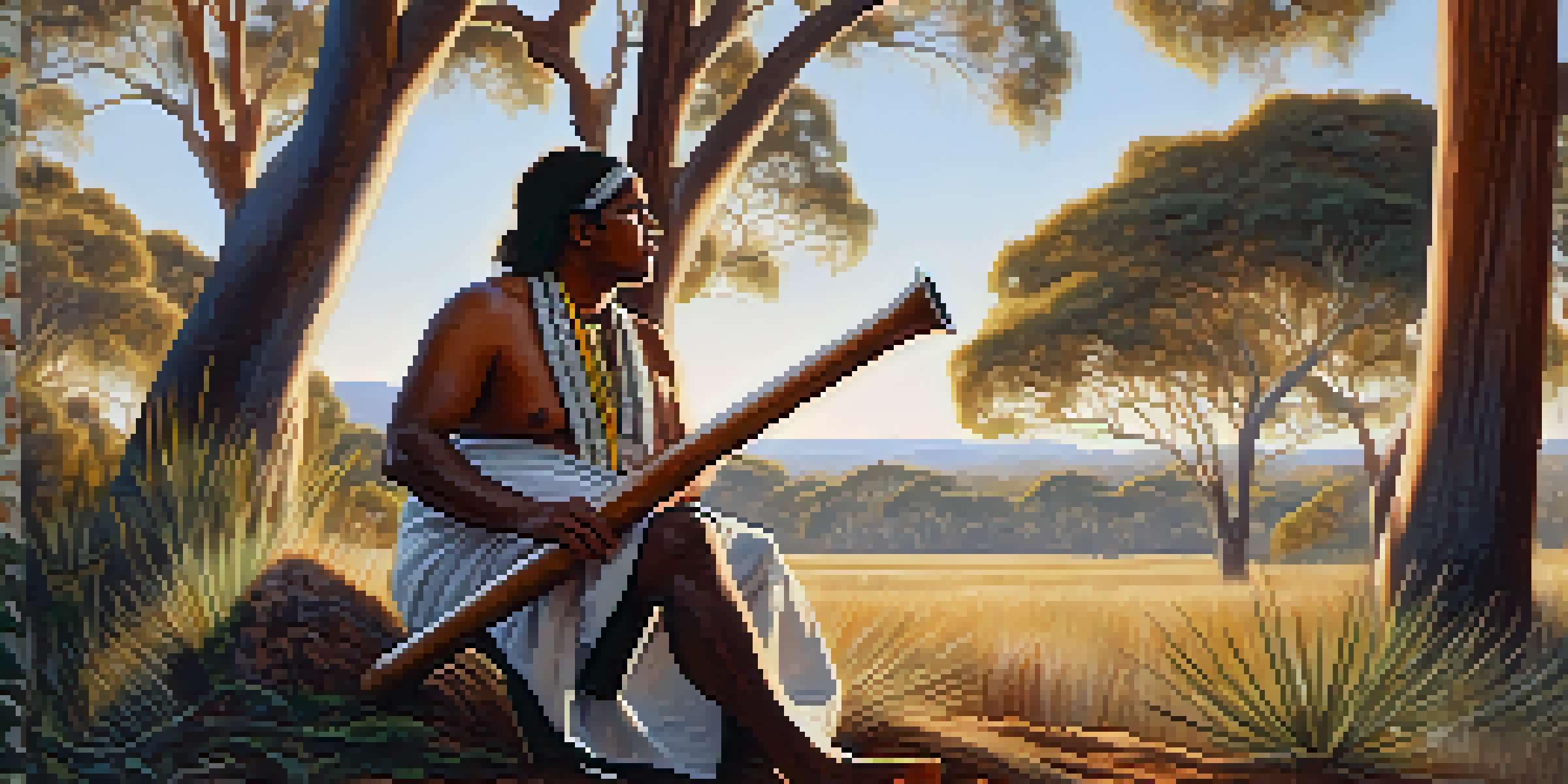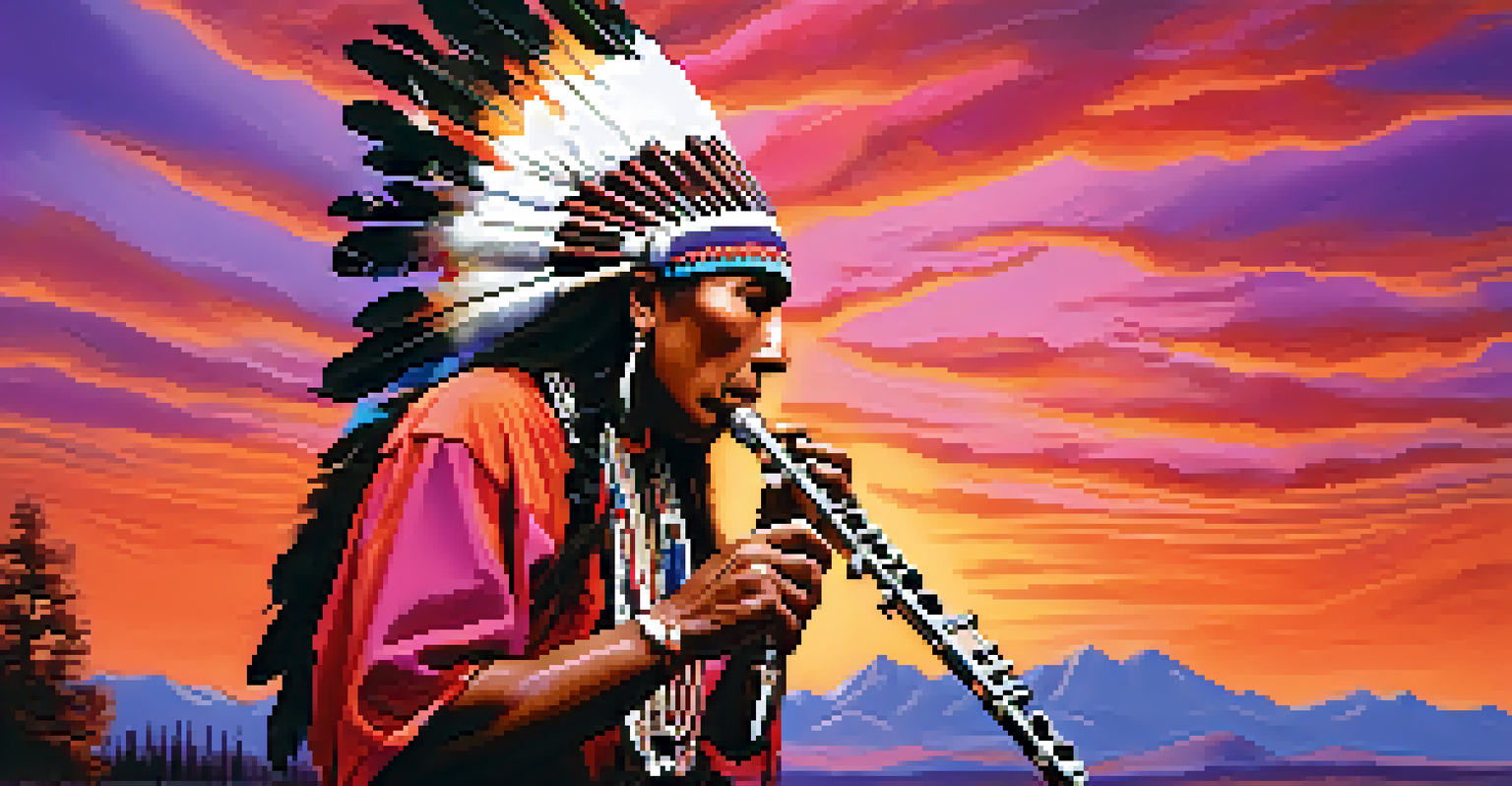The Role of Indigenous Instruments in Cultural Music Traditions

Understanding Indigenous Instruments and Their Origins
Indigenous instruments are not just musical tools; they are vital cultural artifacts. Each instrument carries a history that reflects the community's traditions, beliefs, and values. For example, the didgeridoo of Australian Aboriginal culture is not only a musical instrument but also a spiritual symbol used in ceremonies.
Music can change the world because it can change people.
These instruments often originate from locally available materials, showcasing the resourcefulness of indigenous peoples. A simple flute made from bamboo can evoke stories of nature and community, connecting generations through sound. When we hear these instruments, we are also hearing the land and the stories it holds.
Understanding the origins and craftsmanship behind these instruments can deepen our appreciation for the music they produce. They are crafted with care and purpose, often passed down through generations, making each note a testament to the culture it represents.
Cultural Significance of Indigenous Instruments in Music
Indigenous instruments often play a crucial role in cultural rituals and storytelling. They serve as a medium through which communities express their identity and heritage. For instance, the use of the Native American flute in spiritual ceremonies emphasizes the connection between music, nature, and the divine.

These instruments are not just for entertainment; they are integral to communal gatherings, celebrations, and rites of passage. The sounds produced resonate with the audience on a deeper level, often evoking emotions that words cannot capture. Music becomes a shared experience, reinforcing community bonds.
Cultural Roots of Indigenous Instruments
Indigenous instruments carry deep cultural significance, reflecting the traditions and values of their communities.
Moreover, the unique sounds of indigenous instruments can transport listeners to a different time and place, enabling a sense of connection to the past. This cultural significance enriches the experience of the music, reminding us that each melody carries with it a wealth of history and tradition.
Preservation of Indigenous Musical Traditions
As globalization spreads, the challenge of preserving indigenous musical traditions becomes increasingly critical. Many indigenous communities are actively working to keep their musical heritage alive, often through educational programs and cultural festivals. These initiatives not only celebrate their music but also educate the wider public about its significance.
The best way to predict the future is to create it.
Keeping these traditions alive requires a focus on intergenerational knowledge transfer. Elders play a vital role in teaching younger generations how to play traditional instruments and understand their cultural context. This passing of knowledge ensures that the music remains vibrant and relevant.
Additionally, collaborations between indigenous musicians and contemporary artists are fostering a revival of interest in traditional music. These partnerships can blend modern styles with indigenous sounds, creating new forms of expression while honoring the roots of the music.
The Role of Indigenous Instruments in Storytelling
Storytelling is a fundamental aspect of many cultures, and indigenous instruments are often used to enhance these narratives. They help convey emotions and set the atmosphere, making stories come alive in a unique way. For instance, the rhythmic beats of a drum can intensify a tale, drawing listeners deeper into the experience.
Many indigenous stories are intertwined with the sounds of nature, and instruments serve as a bridge between the two. A simple stringed instrument might mimic the sound of a flowing river, connecting the listener to the natural world. This relationship between sound and story highlights the importance of the environment in indigenous traditions.
Challenges in Preserving Traditions
Globalization poses challenges to the preservation of indigenous musical traditions, necessitating active efforts for their survival.
Furthermore, the music can serve as a mnemonic device, helping to preserve oral histories that might otherwise be forgotten. Just as a catchy tune can stick in your head, the melodies associated with particular stories ensure that they are passed down and remembered through generations.
Indigenous Instruments in Contemporary Music
In recent years, indigenous instruments have found their way into contemporary music genres, offering a fresh perspective on traditional sounds. Artists across various genres are incorporating these instruments, creating a fusion that resonates with diverse audiences. This blend not only showcases the beauty of indigenous music but also introduces it to a broader audience.
For example, collaborations between indigenous musicians and popular artists can result in powerful musical statements that celebrate cultural diversity. These collaborations can pave the way for greater recognition and appreciation of indigenous musical traditions. They highlight the relevance of these instruments in today's world.
This trend also opens up discussions about cultural appropriation versus appreciation. While blending genres can be a way to honor indigenous music, it's essential to approach these collaborations with respect and understanding of the cultural significance behind the instruments.
Challenges Facing Indigenous Music Today
Despite the resurgence of interest in indigenous music, many challenges persist. Issues such as commercialization, misrepresentation, and cultural appropriation can undermine the authenticity of traditional music. It’s crucial for audiences and musicians alike to engage with indigenous cultures respectfully and thoughtfully.
Moreover, the impact of modern technology can both help and hinder. While social media and streaming platforms provide a space for indigenous artists to share their music, they can also lead to the dilution of cultural elements when not approached carefully. Balancing visibility with authenticity is a delicate dance in the digital age.
Future of Indigenous Music in Fusion
The integration of indigenous instruments into contemporary music offers opportunities for cultural appreciation and collaboration.
Finally, funding and support for indigenous music initiatives can be inconsistent. Many communities rely on grants and donations to sustain their musical traditions. Ensuring that these communities have the resources they need to thrive is vital for the preservation of their rich musical heritage.
The Future of Indigenous Instruments in Global Music
Looking ahead, the future of indigenous instruments in global music is promising yet uncertain. As awareness of cultural diversity grows, there is an increasing appreciation for the unique sounds and stories that indigenous instruments bring. This trend could foster a greater respect for indigenous cultures and their contributions to the world of music.
Educational programs and cultural exchanges can play a significant role in this future. By fostering an understanding of indigenous music and its cultural context, we can cultivate a more inclusive music scene that values authenticity. Workshops and collaborations can bridge gaps between cultures, creating a richer musical tapestry.

Ultimately, the success of indigenous instruments in global music will depend on mutual respect and collaboration. Embracing these instruments means honoring their history and significance, ensuring that they continue to resonate with audiences for generations to come.